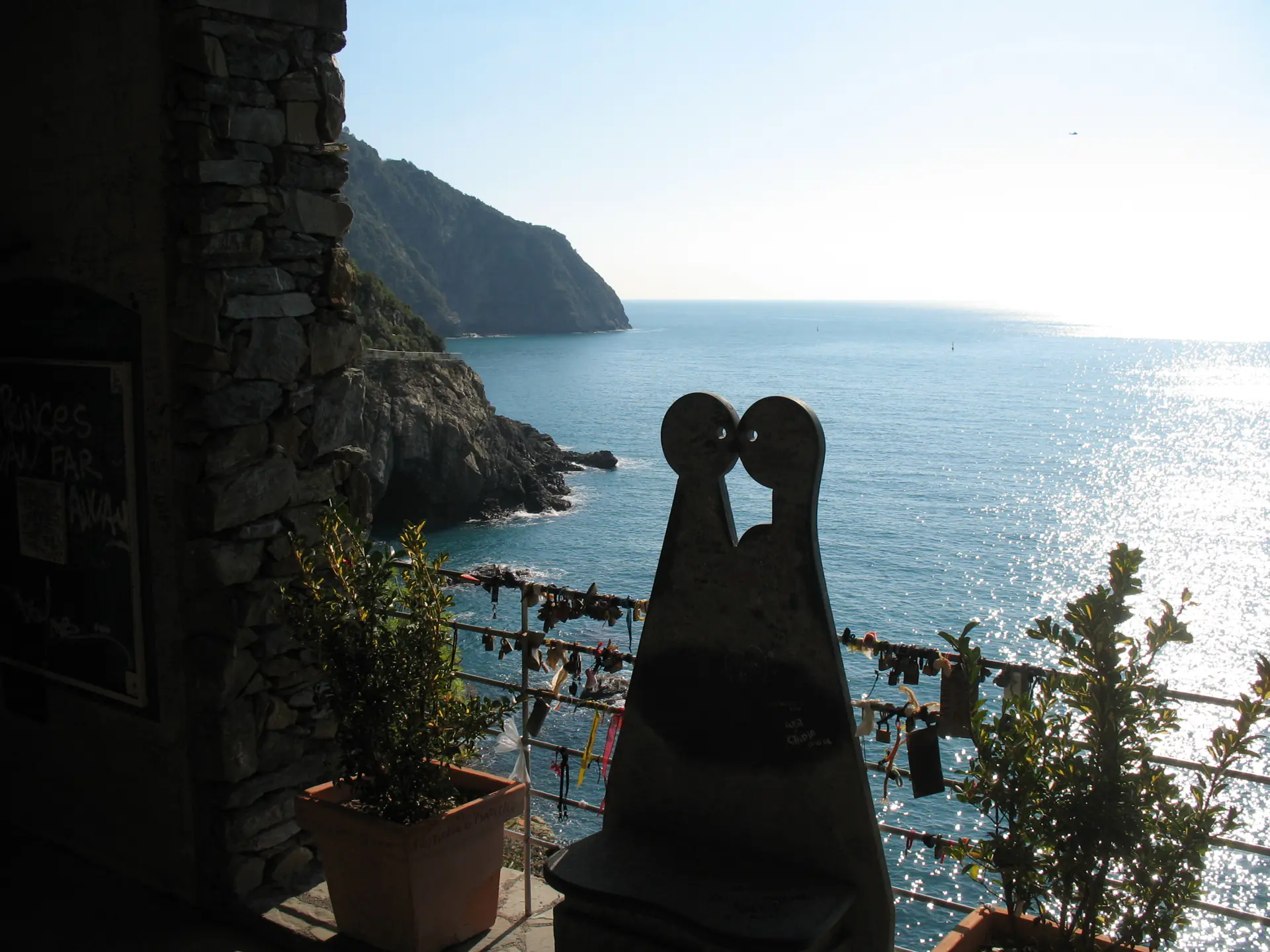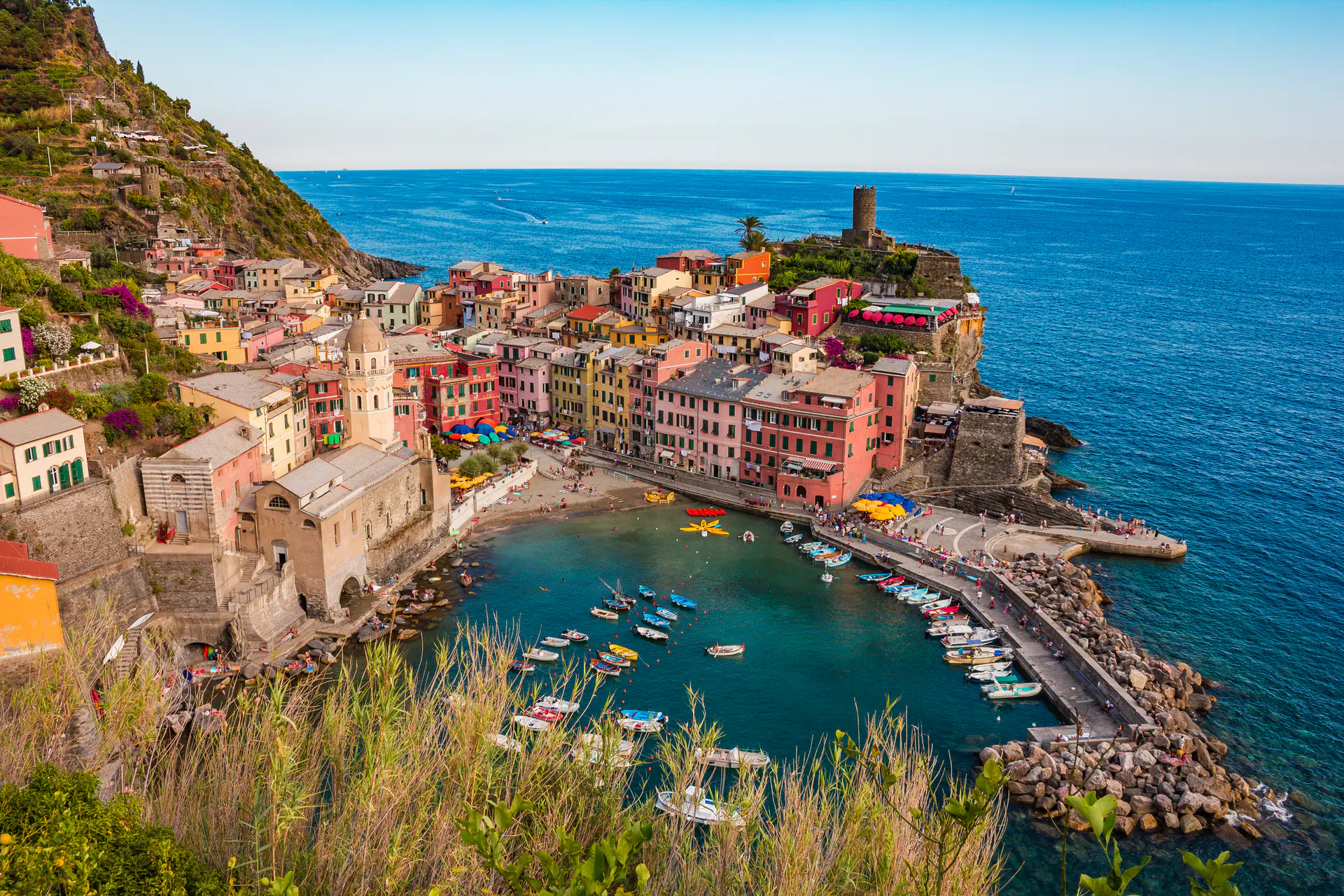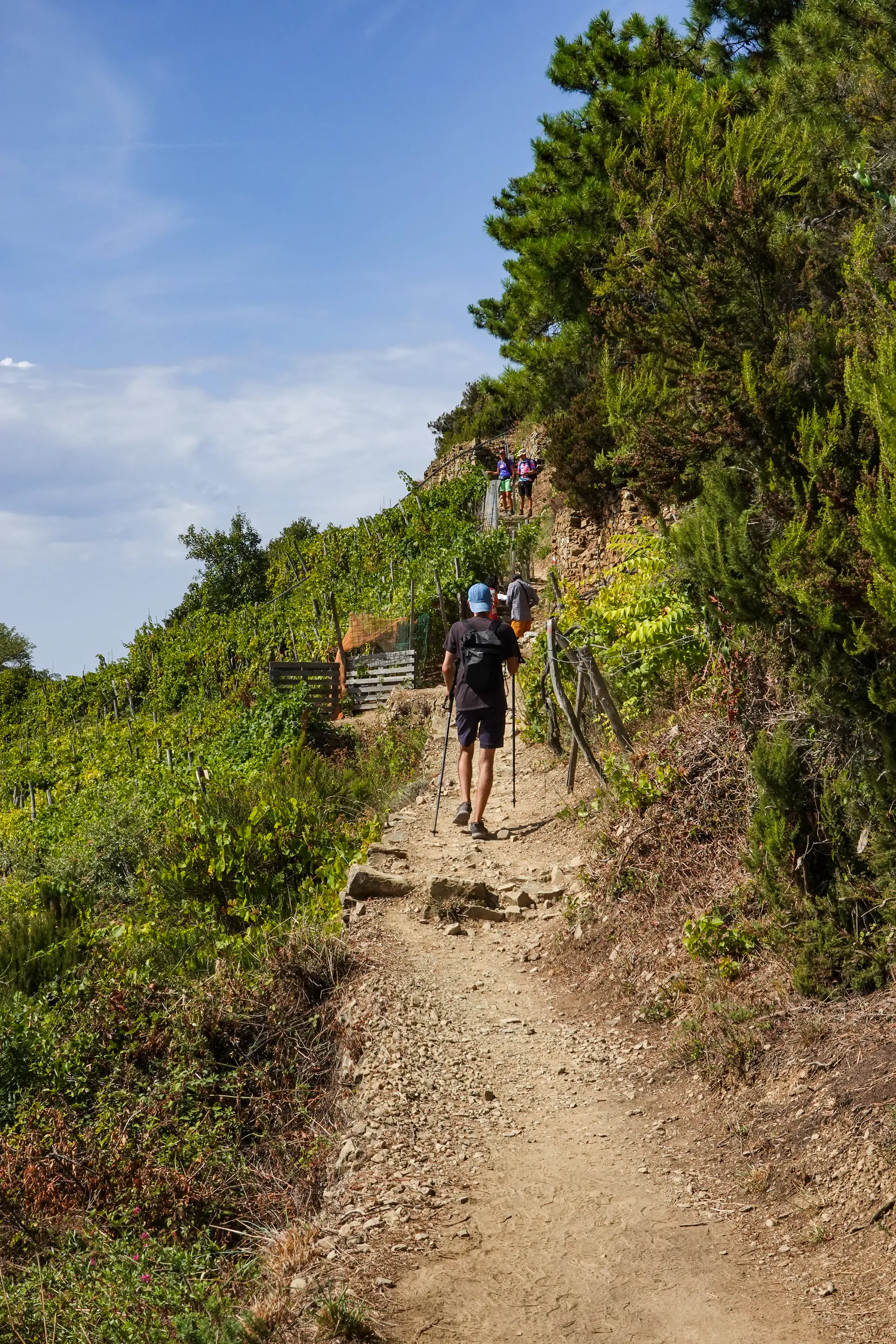
Cinque Terre: Five Coastal Villages & Ligurian Cliffs
Five Villages Clinging to Ligurian Cliffs
About This Site
Medieval Ligurian communities established five fishing villages between the 11th and 13th centuries along sheer coastal cliffs, building colorful tower houses directly into rocky shores to defend against Saracen pirates while maximizing scarce flat land. The inhabitants developed "heroic viticulture" techniques over 1,000 years, constructing 6,700 kilometers of dry stone walls to create terraced vineyards on impossibly steep slopes that produce renowned Cinque Terre DOC wines and exceptional Sciacchetrà dessert wine. The villages--Monterosso al Mare, Vernazza, Corniglia, Manarola, and Riomaggiore--remain connected by ancient coastal pathways and the 11th-century Church of Santa Margherita d'Antiochia in Vernazza, while the fortified medieval harbor town of Portovenere with its 12th-century Church of San Pietro extends the cultural landscape south to the islands of Palmaria, Tino, and Tinetto.
Why It Matters
This exceptional cultural landscape demonstrates over a millennium of harmonious human adaptation to one of the Mediterranean's most challenging coastal environments. The site preserves traditional settlement patterns, agricultural practices, and distinctive defensive architecture that profoundly influenced coastal development throughout Southern Europe while sustaining continuous communities through remarkable landscape modification techniques.
Planning Your Trip
Essential information for visiting this destination
Getting There
Regional trains connect all five villages with frequent service from La Spezia Centrale station 15 minutes south, providing easiest access from Pisa Airport or Florence with convenient connections. Genoa serves as northern gateway with direct coastal trains through scenic Ligurian Riviera showcasing Mediterranean coastline and dramatic cliffside views. The Cinque Terre Card includes unlimited train travel between villages plus hiking trail access and bus services connecting high zones. Private cars face severe restrictions with extremely limited parking, making train arrival strongly recommended for all visitors exploring the coastline.
Where to Stay
La Spezia mainland city 15 minutes by train offers abundant hotels and apartments at significantly lower prices than Cinque Terre villages, with excellent restaurant options and convenient access. This practical base suits budget-conscious travelers and longer stays requiring economical alternatives. Monterosso al Mare largest village provides most accommodation options within Cinque Terre including hotels near sandy beaches, though higher prices reflect limited availability and prime coastal positioning. Central location enables easy exploration. Smaller villages Vernazza, Manarola, and Riomaggiore offer limited rooms requiring months-ahead booking for April-October peak season. Atmospheric medieval settings deliver authentic experiences despite premium pricing and challenging luggage transport up steep stairs.
Where to Eat
Ligurian cuisine emphasizes pesto alla genovese with basil, pine nuts, and Parmigiano creating vibrant green sauce, trofie pasta, and fresh anchovies from local waters served in village trattorias throughout picturesque streets. Seafood dominates menus including grilled catch, stuffed mussels, and seafood risotto reflecting centuries of fishing heritage passed through generations of coastal families. Cinque Terre DOC white wines and rare Sciacchetrà dessert wine from terraced vineyards provide distinctive tasting experiences showcasing heroic viticulture on impossibly steep slopes. Focaccia bakeries offer traditional Ligurian flatbread fresh throughout the day. Restaurants near harbors command premium prices while inland locations deliver better value with authentic local character.
Things to Do
Cinque Terre Card grants access to hiking trails including Sentiero Azzurro coastal path connecting villages through dramatic scenery, though check current closures as sections undergo restoration following landslide damage. Via dell'Amore between Riomaggiore and Manarola reopened August 2024 requiring advance booking and €7.50 ($9 USD) entrance fee. Boat services April-October provide alternative village connections with spectacular coastal perspectives, with tickets typically costing €15-35 ($18-41 USD) depending on route and season. Vineyard tours (€20-40 / $24-47 USD) demonstrate heroic viticulture on impossibly steep terraces with wine tastings of local productions showcasing traditional methods perfected over generations. Swimming from rocky beaches and harbor areas offers authentic Mediterranean coastal experiences during warm summer months. Portovenere medieval harbor town and Palmaria island day trips extend exploration beyond five main villages. Guided hiking tours (€40-60 / $47-71 USD per person) provide expert-led experiences with local insights on flora, history, and photography opportunities. Cooking classes (€60-90 / $71-106 USD) teach traditional Ligurian pesto preparation techniques using fresh local basil in hands-on sessions with local chefs.
Travel Essentials
Comprehensive travel insurance covering trip cancellations essential given frequent trail closures from landslides potentially disrupting hiking plans and limiting village access during extreme weather events. International eSIM cards provide data connectivity throughout villages and trains, enabling navigation apps, trail status updates, and online booking systems for accommodation and restaurants while maintaining communication. EU citizens should carry European Health Insurance Cards (EHIC) for reciprocal healthcare access within Italy. Cinque Terre trails range from easy paved paths to strenuous climbs requiring proper hiking boots with excellent grip for steep rocky terrain. Pack sun protection, abundant water, and lightweight layers for changeable coastal weather. Italy uses Type C and F electrical outlets (220V). Summer temperatures exceed 30°C with intense sun exposure on exposed trails. April-May and September-October shoulder seasons offer optimal hiking conditions while avoiding July-August peak crowds when 4 million annual visitors concentrate in tiny villages designed for fewer than 4,000 residents.
Loading map...
Visitor Information
Everything you need to know for your visit
What to Bring
Sturdy hiking boots for rocky Sentiero Azzurro trails, sun protection, water bottle (refill at fountains), swimwear for beaches, day pack, camera, and Cinque Terre Card for trains and trails.
Accessibility
Villages accessible by regional train with frequent service. Steep terrain and narrow pathways make wheelchair access extremely challenging. Private cars restricted in village centers.
Safety Tips
Coastal trails can be strenuous with landslide closures. Wear proper footwear and check trail status. Via dell'Amore requires advance booking.
Cultural Treasures

Terraced Vineyards and Heroic Viticulture
Cinque Terre's most remarkable feature extends far beyond the picturesque villages--the extraordinary terraced vineyards that blanket impossibly steep coastal slopes, supported by an astonishing 6,700 kilometers of dry stone walls built over centuries without mortar. This "heroic viticulture" represents human determination to cultivate wine on terrain where mechanization remains impossible, requiring manual harvesting where workers carry grape-filled baskets weighing 30-40 kilograms up near-vertical paths. These ancient terraces produce distinctive Cinque Terre DOC white wines and the rare Sciacchetrà dessert wine, crafted from sun-dried grapes following traditions dating back 1,000 years. Despite their UNESCO recognition, approximately 95% of historic terraces now lie abandoned as younger generations pursue less arduous livelihoods, threatening this millennium-old agricultural heritage. Pro tip: Book vineyard tours (€20-40 / $24-47 USD) in Manarola or Corniglia for autumn (September-October) harvest season--you'll witness heroic viticulture firsthand as workers carry 30-40kg grape baskets up near-vertical paths, plus taste exceptional Sciacchetrà dessert wine directly from producers.

Via dell'Amore Coastal Path
The legendary Via dell'Amore (Path of Love) between Riomaggiore and Manarola ranks among the world's most romantic coastal walks, carved into sheer cliffs overlooking the Ligurian Sea's azure waters. This 980-meter paved pathway, reopened in August 2024 after 12 years of closure following devastating landslides, offers breathtaking Mediterranean vistas while connecting two of Cinque Terre's most photogenic villages. Historical tradition held that young lovers from the two communities would meet secretly along this path, giving rise to its romantic name. Today, advance booking is mandatory with daily visitor limits protecting both restored infrastructure and visitor safety, while the entrance fee supports ongoing maintenance.

Sentiero Azzurro (Blue Trail)
The Sentiero Azzurro represents Cinque Terre's premier coastal hiking route, traversing approximately 12 kilometers of spectacular Ligurian coastline while connecting all five villages through ancient mule tracks and cliffside pathways. This moderately challenging trail typically requires 5-6 hours of walking time, rewarding hikers with breathtaking panoramic views encompassing terraced vineyards, medieval villages, and endless Mediterranean seascapes. The trail's condition varies significantly by section--while portions remain beautifully maintained, the segment between Manarola and Corniglia faces closure until at least 2028 for extensive restoration following landslide damage. The recently reopened Via dell'Amore constitutes the trail's easiest section, while the Monterosso-Vernazza segment challenges hikers with steeper ascents through terraced landscapes.

Colorful Coastal Villages and Traditional Architecture
Cinque Terre's five villages showcase extraordinary architectural adaptation to extreme coastal topography, where colorful tower houses rise four to five storeys directly from rocky shores in vibrant yellows, pinks, oranges, and terracotta hues. These distinctive buildings, painted in traditional pastel colors that fishermen could recognize from the sea, demonstrate medieval Ligurian defensive architecture adapted to precipitous terrain. Vernazza's natural harbor, surrounded by houses cascading down to the waterfront piazza, creates perhaps Italy's most photographed village scene. Corniglia perches atop a 100-meter promontory, accessible via 382 brick steps. Riomaggiore's tall, narrow houses tumble down a steep ravine to a tiny harbor, while Monterosso offers the only significant beaches. Pro tip: Arrive in Vernazza before 9am when morning light illuminates the harbor and cruise ship day-trippers haven't yet arrived. Hike Monterosso-Vernazza starting at 7:30am to complete before midday heat and secure waterfront lunch tables by 12:30pm. Visit Manarola's harbor viewpoint at 6:30pm for golden hour light with fewer crowds than sunset (7:30-8pm).

Sanctuary Trails and Pilgrimage Routes
Beyond the famous coastal paths, ancient sanctuary trails climb steeply inland from each village to hilltop sanctuaries offering spectacular elevated perspectives across the cultural landscape. These historic pilgrimage routes wind through olive groves, chestnut forests, and abandoned terraces while ascending 300-500 meters. The Sanctuary of Nostra Signora di Soviore above Monterosso, documented from the 13th century, ranks as Liguria's oldest Marian sanctuary. These trails provide peaceful alternatives to crowded coastal routes while revealing the broader agricultural landscape that sustained village communities throughout history, offering intimate encounters with traditional stone structures, ancient cultivation terraces, and panoramic vistas encompassing the Ligurian coastline from elevated vantage points accessible only on foot.
Historical Context
Early Medieval Settlement (8th-11th Centuries)
The earliest documented settlements emerged during the 8th century, with Riomaggiore founded around 700 CE as the oldest village. Communities developed around small harbors and defensive positions along the previously uninhabited Ligurian coast, establishing the characteristic settlement pattern of compact villages separated by rugged terrain and connected by footpaths.
Maritime Republic Era (11th-13th Centuries)
Under the protection of the Republic of Genoa from the 11th century, the villages flourished as strategic coastal settlements. The distinctive tower houses, defensive structures, and harbor fortifications date primarily from this period, while the Genoese introduced agricultural techniques including terraced viticulture that would define the landscape for a millennium.
Agricultural Development (14th-19th Centuries)
Communities developed the extensive terracing system defining Cinque Terre's landscape, painstakingly constructing 6,700 kilometers of dry stone walls. Wine production, olive cultivation, and fishing sustained isolated villages connected primarily by sea and ancient mule tracks.
Railway Connection and Accessibility (1874)
The Genoa-La Spezia railway line completion in 1874, with tunnels connecting all five villages, ended centuries of isolation. The railway brought new economic opportunities while transforming traditional economy. Villages retained medieval character despite improved accessibility.
UNESCO Recognition and Tourism Era (1997-Present)
UNESCO World Heritage inscription in 1997 recognized the exceptional cultural landscape, triggering dramatic tourism growth from 300,000 annual visitors to over 4 million today. Cinque Terre National Park, established 1999, balances conservation with sustainable tourism.
Conservation
Current Status
Cinque Terre faces critical challenges from overtourism, agricultural abandonment, and climate-related landslides threatening the integrity of this fragile cultural landscape.
Challenges
- Overtourism overwhelming five villages with 4 million annual visitors in 1 square kilometer designed for fewer than 4,000 permanent residents
- Agricultural abandonment with 95% of historic terraced vineyards no longer cultivated as younger generations reject arduous manual labor
- Terrace degradation and landslide risk as abandoned dry stone walls collapse without maintenance, increasing erosion and threatening trails and villages
- Climate change impacts intensifying extreme rainfall events, causing landslides that repeatedly close hiking trails and damage infrastructure
- Population decline from 7,000 to fewer than 4,000 residents as tourism displaces traditional livelihoods, housing costs soar, and ancestral knowledge disappears
Conservation Efforts
- Daily visitor capacity limits and advance booking requirements for Via dell'Amore implemented to reduce overcrowding and manage tourist flows
- Cinque Terre National Park established in 1999 providing comprehensive landscape protection and coordinating conservation across the five villages with support from Cinque Terre Card revenue directly funding conservation and sustainable tourism infrastructure
- Trail restoration programs investing millions in rebuilding coastal paths with improved drainage, reinforced structures, and landslide prevention projects strengthening unstable slopes while improving water management
- Terrace recovery initiatives providing financial incentives and technical support to farmers reviving abandoned vineyards, with agricultural cooperatives supporting traditional wine production and training new generations in heroic viticulture techniques
- UNESCO monitoring ensuring compliance with World Heritage commitments while addressing overtourism through visitor management strategies and sustainable tourism development
Frequently Asked Questions
Yes, if you visit April-May or September-October when crowds are manageable. The dramatic coastal scenery, colorful villages, terraced vineyards, and authentic Italian culture justify the UNESCO designation. Avoid July-August when 4 million annual tourists create overwhelming congestion in tiny villages.
Villages are free to enter. The Cinque Terre Card costs €18.20 ($21 USD) for 1-day, €33 ($39 USD) for 2-day, or €47 ($55 USD) for 3-day, including unlimited trains between villages and hiking trail access. Via dell'Amore costs €7.50 ($9 USD) separately. Accommodation and dining vary widely by budget (€60-400 / $71-472 USD daily).
Absolutely essential. Five villages have limited accommodation (3,000 beds total) filling 3-6 months ahead for April-October. Consider staying in La Spezia or Levanto for better availability, lower prices, and easy train access while avoiding village congestion.
Late April through May and September-October provide ideal conditions with pleasant temperatures averaging 18-24°C, fewer crowds, and reliable trail access. Summer months July-August should be avoided when approximately 4 million annual tourists create overwhelming congestion in these tiny villages.
The regional train connects all five villages with frequent service throughout the day. The Cinque Terre Card includes unlimited train travel plus hiking trail access. Boats operate April-October, while the Sentiero Azzurro offers coastal hiking (check closures).
Private vehicles face severe restrictions with extremely limited parking spaces (expensive and often full). The narrow coastal road is challenging and parking is nearly impossible during peak season. Arriving by train is therefore strongly recommended for convenience.
The Via dell'Amore reopened in August 2024 after 12 years of closure following extensive restoration. The 980-meter path requires advance booking with limited daily capacity and charges an entry fee. The Manarola-Corniglia section remains closed until 2028.
The five villages are Monterosso al Mare (largest with sandy beaches), Vernazza (picturesque harbor), Corniglia (perched 100 meters above sea level), Manarola (dramatic terraced vineyards), and Riomaggiore (oldest settlement), forming a UNESCO World Heritage cultural landscape along Italy's Ligurian coast.
Heroic viticulture ("viticoltura eroica") describes extraordinary wine-making on impossibly steep terraces supported by 6,700 kilometers of dry stone walls. Manual harvesting requires carrying grape-filled baskets up paths since mechanization is impossible. This thousand-year-old practice produces distinctive Cinque Terre DOC wines and rare Sciacchetrà dessert wine.
Yes, overtourism is the primary challenge with 4 million annual visitors overwhelming villages designed for fewer than 4,000 residents in 1 square kilometer. Daily visitor caps, advance booking systems, and seasonal restrictions aim to manage crowds. Visiting shoulder seasons (April-May, September-October) significantly improves the experience.
UNESCO World Heritage Criteria
Inscribed in 1997, this site meets 3 of UNESCO's 10 criteria for Outstanding Universal Value
Criterion (ii): Interchange of human values
The Ligurian coast demonstrates exceptional interchange of human values through medieval defensive systems, Genoese architectural influences, and fishing village layouts that profoundly influenced Mediterranean coastal development, while "heroic viticulture" techniques perfected here shaped terraced wine production across steep maritime landscapes.
Criterion (iv): Outstanding architectural/technological ensemble
The villages exemplify outstanding traditional settlement integrated with dramatic coastal topography. Colorful tower houses rising from rocky shores, defensive structures on precipitous cliffs, and terraced vineyards supported by 6,700 kilometers of dry stone walls demonstrate exceptional landscape modification techniques.
Criterion (v): Outstanding traditional human settlement
This vulnerable cultural landscape sustained communities for over 1,000 years through "heroic viticulture" on impossible terrain. The extensive terracing system, fishing traditions, and ancient pathways demonstrate exceptional human-environment interaction threatened by depopulation, agricultural abandonment, and mass tourism.
Image & Content Attribution
Research & Content Sources
Photography & Visual Media
Last updated: 2 November 2025